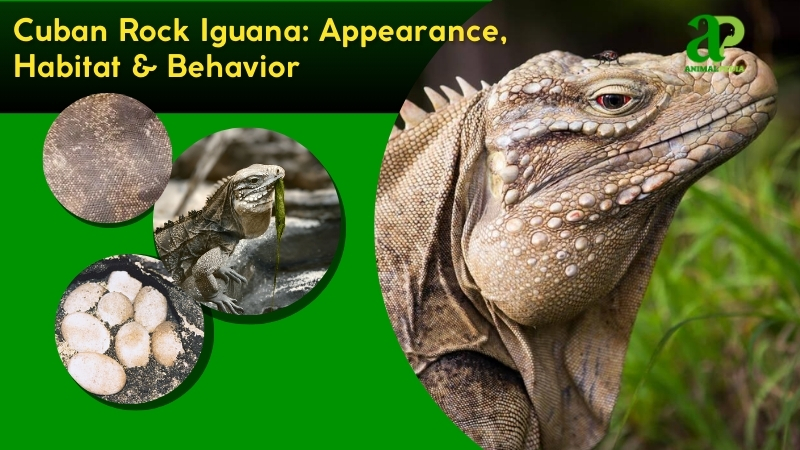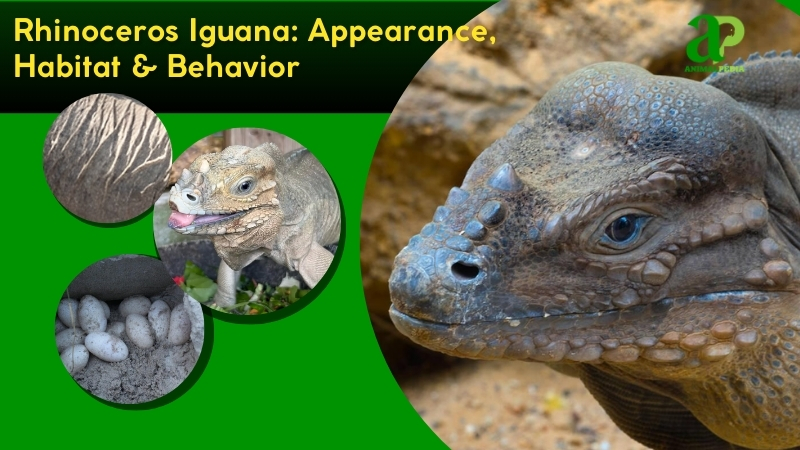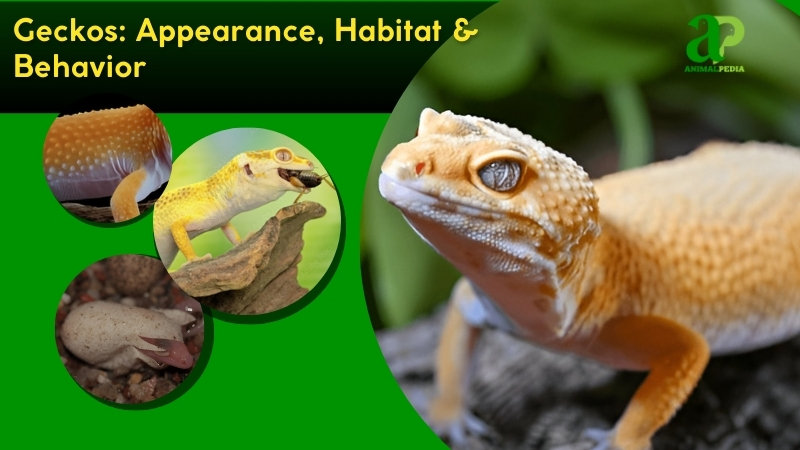Iguanas, large lizards with vibrant green to grayish-green scales, comprise about 35 species, primarily within the family Iguanidae. Their robust bodies, long tails, and dewlaps create distinctive profiles, with sizes ranging from 14 cm Cyclura hatchlings to 2-meter Iguana iguana adults. They dominate tropical ecosystems across the Galápagos archipelago, Caribbean islands, and Central/South American regions.
Notable species include Iguana iguana (the green iguana), Cyclura nubila (the Cuban rock iguana), and Amblyrhynchus cristatus (the Galápagos marine iguana). Green iguanas thrive in trees, while marine iguanas—unique reptilian swimmers—dive for algae. Cuban iguanas prefer rocky habitats, demonstrating clear niche specialization.
Morphological adaptations define these reptiles. Most follow herbivorous diets and possess prehensile tails, which aid in balance. Island endemics inhabit Jamaica, Grand Cayman, and the Galápagos, typically reaching heights of 1-2 meters at maturity. The marine iguana expels salt through specialized nasal glands, while green iguanas use dewlaps for thermoregulation—evolutionary solutions to environmental challenges.
In food webs, iguanas function not as predators but as specialized feeders. Green iguanas consume leaves and fruits, while marine iguanas harvest underwater algae. Their foraging behavior involves no active hunting. Human-wildlife conflicts vary—captive green iguanas popular, yet invasive populations disrupt native ecosystems. Natural predators include birds of prey and medium-sized mammals.
Reproduction coincides with wet seasons. Females deposit 20-70 eggs in excavated burrows, with incubation lasting 10-16 weeks. Hatchlings emerge self-sufficient, foraging immediately. Sexual maturity requires 2-4 years, with typical lifespans reaching 10-20 years. This overview highlights iguanas’ biodiversity, ecological significance, and evolutionary adaptations across their insular habitats.
This article examines iguanas’ physical characteristics, habitat requirements, and behavioral patterns, revealing their critical roles in tropical ecosystems.
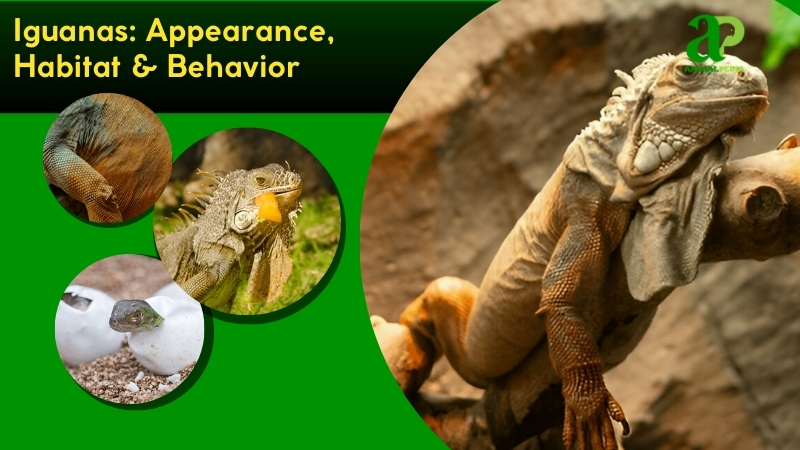
What do the Iguanas look like?
Iguanas have robust, elongated bodies with rough, scaly skin. Green iguanas (Iguana iguana) display vibrant emerald coloration, while Lesser Antillean iguanas (Iguana delicatissima) exhibit grayish-brown hues, often with distinctive banded patterns. Their coarse skin texture provides essential protection against environmental abrasions.
These features of reptiles include a broad head with small, alert eyes for environmental scanning. They possess short tongues, thick necks with expandable dewlaps for territorial and mating displays, and muscular bodies built for arboreal living.
A notable feature of iguanas is their long, whip-like tail, which accounts for nearly half their total body length. Similar to the Texas Horned Lizard, they rely on physical adaptations for defense—though instead of spines or camouflage, iguanas use tail strikes and swift climbing to escape predators.
Unlike chameleons, iguanas are unable to change their color. Their prominent dorsal spines serve as dominance indicators, a feature absent in related agamid lizards. The bright coloration of green iguanas creates a striking contrast with the subdued tones of monitor lizards, as documented by Breuil and colleagues (2019) in comparative reptile morphology studies.
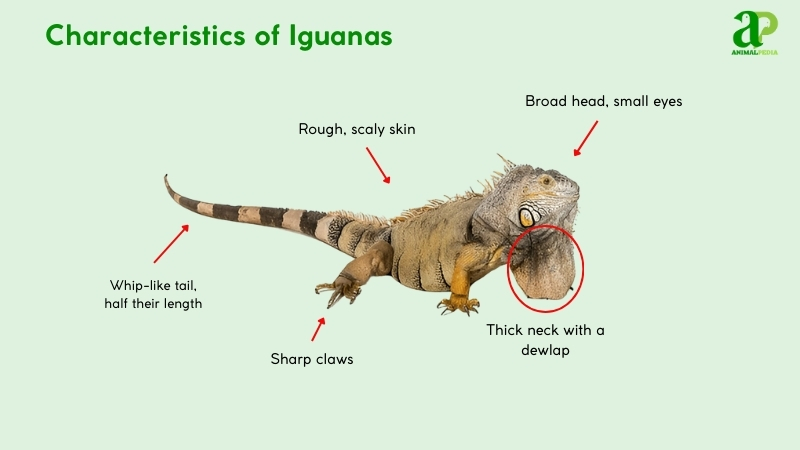
How big do Iguanas get?
Green iguanas typically grow to 4-5 feet (1.2-1.5 meters) in length and weigh 9-13 pounds (4-6 kilograms). The standard adult size of Iguana iguana reaches 5 feet from snout to tail tip.
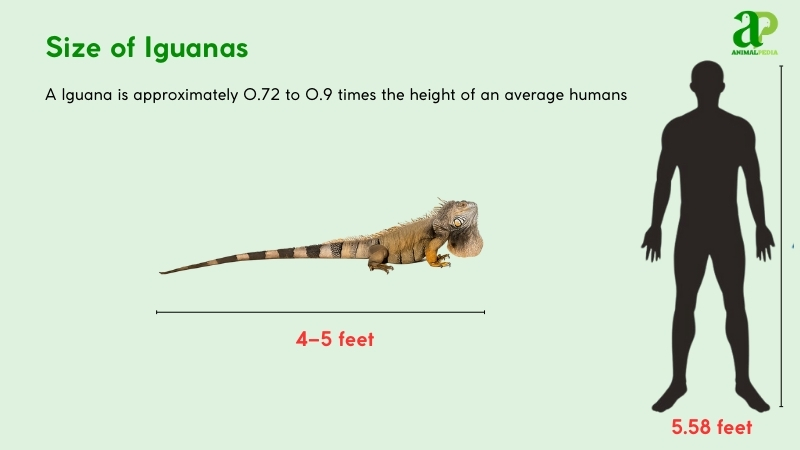
The largest documented specimen measured 7 feet (2.1 meters) and weighed 20 pounds (9.1 kilograms), discovered in Costa Rica according to Krysko’s 2016 research. Male reptiles generally exceed females in size, displaying more prominent dorsal spines used for territorial behavior.
| Trait | Male | Female |
| Length | 5–7 ft (1.5–2.1 m) | 4–5.2 ft (1.2–1.6 m) |
| Weight | 11–20 lbs (5–9 kg) | 9–13 lbs (4–6 kg) |
What are the unique physical characteristics of the Species?
Iguanas possess a prominent dorsal crest of elongated spines, unique among lizards, that runs from their neck to tail. This feature, absent in agamids or monitors, signals dominance and aids thermoregulation.
Studies by Malone et al. (2017) show the crest, composed of keratinized scales, varies by species, with green iguanas (Iguana iguana) boasting spines up to 10 cm long. These structures enhance display during mating, distinguishing iguanas in their arboreal habitats.
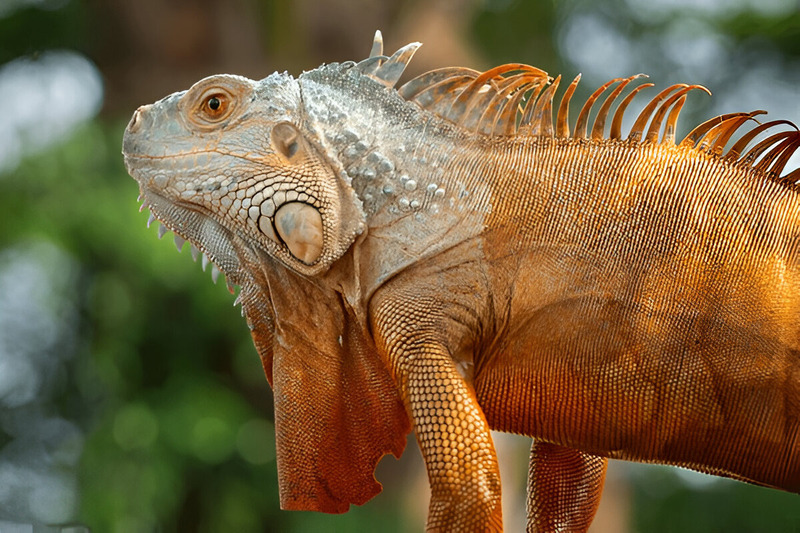
How do Iguanas sense their environment with its unique features?
The dorsal crest functions as a visual signaling system in iguanas, helping them communicate threats effectively, ward off potential predators, and attract mates within their forest habitats. This distinctive anatomical feature enhances visibility during territorial confrontations, improving survival rates.
Binocular vision allows iguanas to detect predators with accuracy, facilitating rapid escape responses. Their chemosensory system includes a highly specialized tongue that samples airborne particles, guiding them to food sources.
Tympanic membranes provide acute auditory perception, allowing iguanas to register subtle environmental sounds that signal danger. Their integumentary thermoreceptors detect ambient temperature variations, enabling precise thermoregulation during basking behaviors essential to their ectothermic physiology.
Anatomy
Iguanas’ internal anatomy shows evolution’s precise adaptations for tropical forests and arid coasts. Their physiology supports an herbivorous lifestyle in diverse habitats from rainforests to coastal regions.
- Respiratory System: Efficient lungs support extended thermoregulation sessions in humid forest canopies, allowing optimal oxygen exchange during both activity and rest periods.
- Circulatory System: The three-chambered heart circulates blood effectively, providing energy for arboreal locomotion and daily foraging activities across varied terrain.
- Digestive System: An elongated intestinal tract houses microbial fermentation chambers that break down cellulose, extracting nutrients from fibrous vegetation that would be indigestible to many other reptiles.
- Excretory System: Specialized renal structures produce uric acid rather than urine, a water-conservation adaptation critical for survival in xeric island environments.
- Nervous System: A well-developed brain coordinates with acute sensory pathways, enabling rapid predator avoidance responses and precise navigation through complex arboreal habitats.
These anatomical features represent crucial adaptations that allow iguanas to process plant material, evade threats, and maintain water balance—essential survival mechanisms in their ecological niches across the Neotropics.
How many types of Iguanas?
Iguana’ species are about 35 different types within the family Iguanidae. Classification uses the Linnaean system, established by Carl Linnaeus, based on morphology and genetics.
The taxonomy branches as: Order Squamata → Family Iguanidae → Genera → Species.
Order Squamata
└── Family Iguanidae
├── Genus Iguana (e.g., I. iguana)
└── Genus Brachylophus (e.g., B. fasciatus)
Special cases include hybrid Iguana iguana x Iguana delicatissima populations, which challenge species boundaries, as noted by Malone et al. (2017).
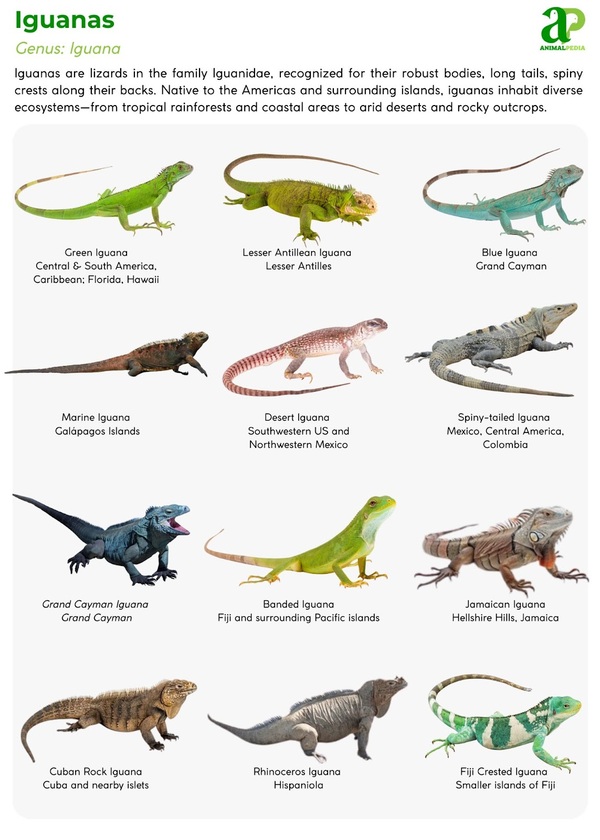
Where do Iguanas live?
Iguanas inhabit regions spanning Central America, South America, the Caribbean (Aruba, Curaçao, Bonaire), and Fiji’s islands. Green iguanas (Iguana iguana) thrive in Costa Rican rainforests, while Lesser Antillean iguanas (Iguana delicatissima) populate Dominica.
These reptiles prefer warm, humid forests and dry scrublands that provide ideal conditions for basking and climbing. The lush vegetation in these habitats supports their herbivorous diet of leaves, flowers, and fruits.
Paleontological evidence confirms iguanas have occupied these tropical regions for approximately 20 million years without a significant geographical shift, according to research by Malone et al. (2017).
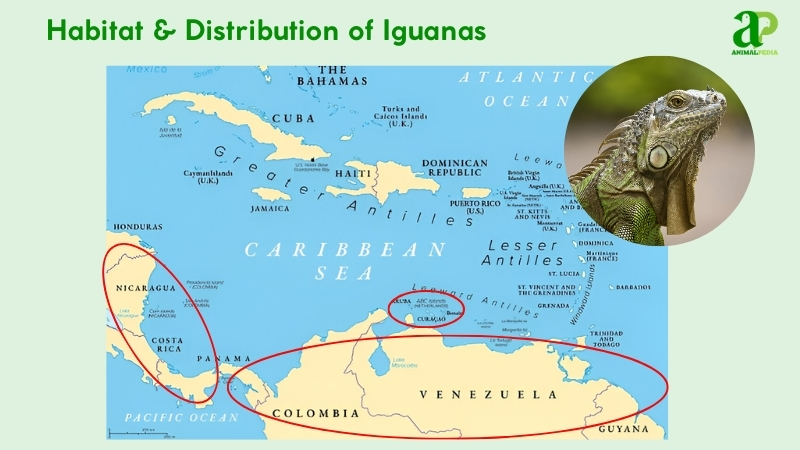
How do seasonal changes affect their behavior?
Iguanas, especially green iguanas, exhibit distinct behavioral and physiological changes in response to seasonal shifts in tropical climates. Their life cycle aligns closely with regional rainfall patterns, which influence food availability, reproduction, and activity levels. Iguanas adapt to two seasons: wet (May-October) and dry (November-April) in tropical regions.
- Wet Season (May-October): Abundant foliage boosts foraging; mating peaks with vibrant male displays.
- Dry Season (November-April): Food scarcity reduces activity; females lay eggs in burrows.
These seasonal adaptations help iguanas conserve energy and optimize reproductive success, enhancing their survival in fluctuating environments.
What is the behavior of Iguanas?
Iguanas exhibit adaptive behaviors shaped by tropical environments, plant-based diets, and evolution. These behaviors support their tree-dwelling, herbivorous lifestyle.
- Feeding Patterns: They consume leaves and fruits on a daily basis. Their digestive process requires sunlight exposure for proper temperature regulation and metabolism.
- Defense Mechanisms: Iguanas are non-venomous reptiles. Do iguanas bite? Yes, but only when threatened. Their bites cause minor injuries. Are iguanas dangerous? No, they pose minimal risk to humans.
- Daily Activities: Basking behavior occurs during morning hours. Iguanas travel 2-3 kilometers daily. They seek arboreal shelter at night to avoid predators.
- Movement Capabilities: Muscular limbs enable effective climbing and swimming. Their powerful tails provide propulsion during brief underwater excursions.
- Social Organization: Primarily solitary creatures, male iguanas establish and defend territories. Females maintain loose spatial associations.
- Communication Methods: Why do iguanas bob their heads? This represents a key signaling behavior. Head-bobbing displays and dewlap extensions establish dominance hierarchies. Tail gestures serve as warning signals to competitors.
These behavioral traits enhance survival through efficient foraging, conflict reduction, and reproductive success in their native tropical ecosystems.
What do Iguanas eat?
Iguanas are strict herbivores, feeding primarily on foliage, blossoms, and fruits such as figs, mangos, and hibiscus. They pose no threat to humans, as their diet consists exclusively of plant matter.
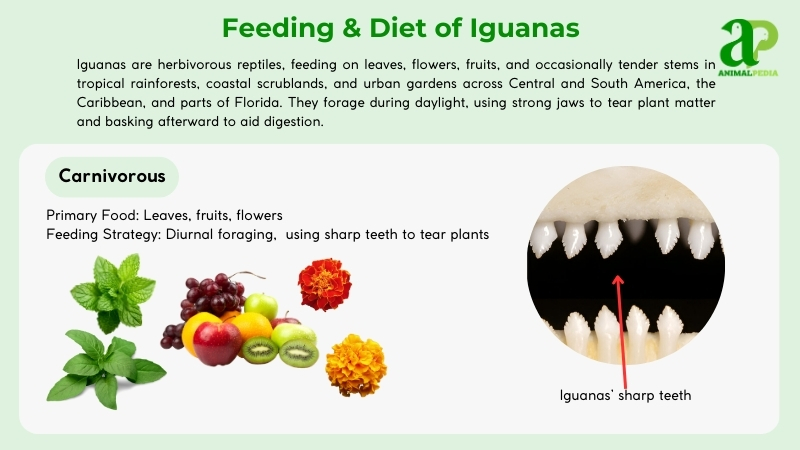
- Diet by Age
Hatchlings prefer soft, tender leaves that are easy to digest, while adults consume tougher vegetation and a wider variety of fruits as their digestive systems mature.
- Diet by Gender
No significant dietary differences exist between males and females—both consume similar plant material, particularly leafy greens.
- Diet by Seasons
During the wet season (May–October), iguanas benefit from abundant fruits and fresh vegetation. In the dry season (November–April), they rely more heavily on durable leaves when fruits become scarce.
Iguanas don’t hunt; instead, they forage during daylight hours, often climbing trees and shrubs to reach food. They use sharp, serrated teeth to slice vegetation into small, manageable pieces. Excessive consumption or large food items can cause choking or regurgitation, especially in captivity or disturbed habitats, per Krysko et al., 2016.
How do Iguanas hunt their prey?

Unlike predatory lizards such as monitors, iguanas possess no hunting skills for capturing animal prey. Their evolutionary adaptation is the specialized consumption of plants.
Their dentition is perfectly designed for shredding fibrous plant material, allowing efficient herbivorous digestion as documented by Krysko and colleagues (2016). Their feeding ecology centers entirely around plant matter rather than the pursuit of prey.
Are Iguanas venomous?
Iguanas are not venomous. These large reptiles use their sharp teeth and powerful jaws to capture prey instead of venom. Their diet consists of insects, plants, and small animals.
Although they lack venom, iguanas exhibit various adaptations. They thermoregulate by basking in sunlight. These reptiles are excellent climbers and strong swimmers, adaptations that help them thrive across diverse ecosystems.
Despite their intimidating appearance with dorsal spines and dewlaps, iguanas are generally non-aggressive reptiles that prefer flight over fight when threatened.
When observing these diurnal lizards in their natural habitat, maintain distance. This respectful approach allows for safe appreciation of these herbivorous reptiles from the family Iguanidae without disturbing their natural behaviors.
When are Iguanas most active during the day?
Iguanas are most active during daylight hours, with peak activity occurring in the morning and late afternoon. They begin their daily cycle at sunrise, when they emerge to bask and raise their body temperature through thermoregulation. During these early hours, iguanas actively forage for vegetation, flowers, and fruits while exploring their territory.
As the midday heat intensifies, iguanas typically reduce their activity level. They seek shade or shelter to prevent overheating, often retreating to burrows, rock crevices, or dense foliage where they rest and digest their morning meals.
The late afternoon brings a second wave of heightened activity. As temperatures moderate, iguanas resume feeding and social behaviors before sunset. During this time, males may perform territorial displays including head-bobbing, dewlap extension, and push-up movements to establish dominance or attract mates.
This crepuscular pattern (active during twilight periods) helps these ectothermic reptiles optimize their energy use while avoiding temperature extremes. Their activity cycle follows the sun to maintain optimal physiological functioning and supports essential behaviors for survival in their natural habitat.
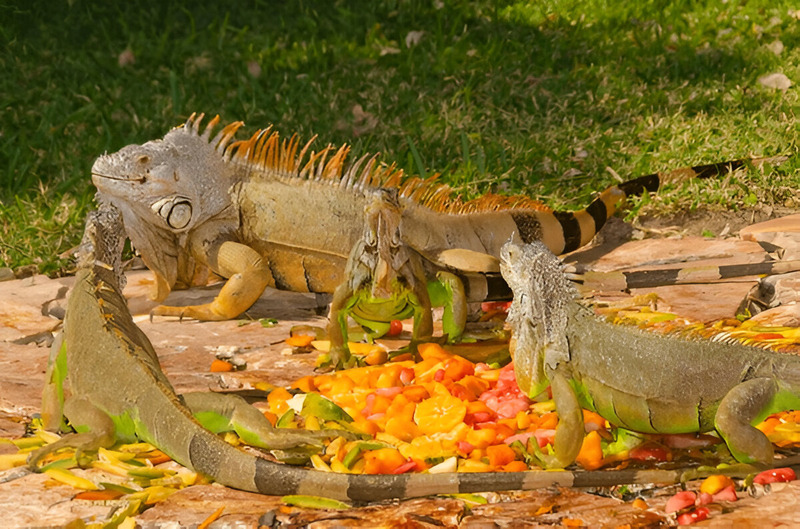
How do Iguanas move on land and water?
Iguanas move with distinct methods on land and in water. On land, these reptiles use powerful legs and sharp claws to climb trees and rocks efficiently. Their agility helps them navigate rough terrain without difficulty.
Land movement for iguanas is purposeful. They can even run on their hind legs when threatened, reaching speeds that are surprising. These cold-blooded creatures often pause for thermoregulation, finding optimal spots to absorb heat from their environment.
In water, iguanas transform into skilled swimmers. They propel themselves using their muscular tails as the primary means of aquatic propulsion. Their streamlined bodies slice through water with minimal resistance, much like small underwater vessels.
The swimming technique of iguanas involves pressing their limbs against their bodies to reduce drag while their tails create a side-to-side motion.
This lateral undulation generates forward thrust, allowing them to travel significant distances in water with energy efficiency. Their ability to adapt to both terrestrial and aquatic environments demonstrates their evolutionary success across diverse habitats.
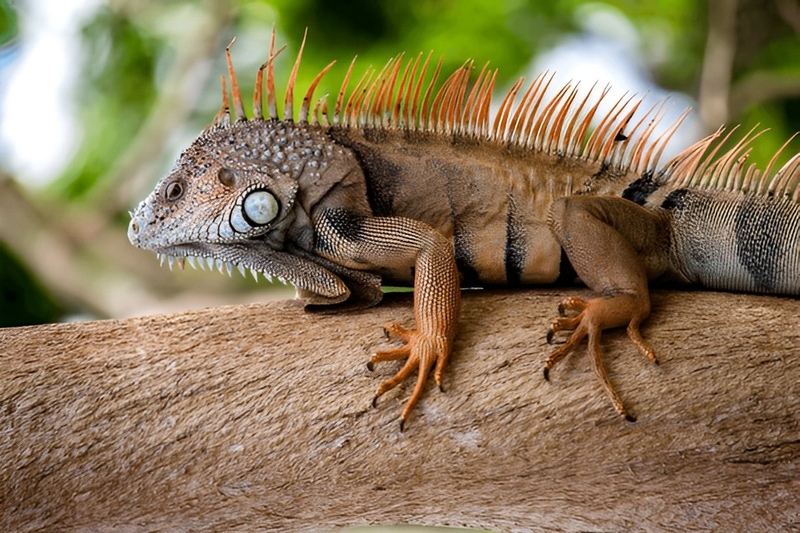
Do Iguanas live alone or in groups?
Iguanas live alone, not in groups. They display solitary behavior and maintain territorial boundaries. These reptiles claim specific areas and defend their territory aggressively from other iguanas. Such independence ensures access to vital resources without competition.
During mating season, these solitary reptiles briefly interact with one another. Once a year, iguanas abandon their isolation to find partners, displaying their vibrant coloration and performing courtship rituals that showcase their species-specific behaviors.
After reproduction, iguanas return to a solitary existence. This pattern of independence persists across various habitats, from tropical forests to coastal regions, supporting their survival as predominantly solitary creatures.
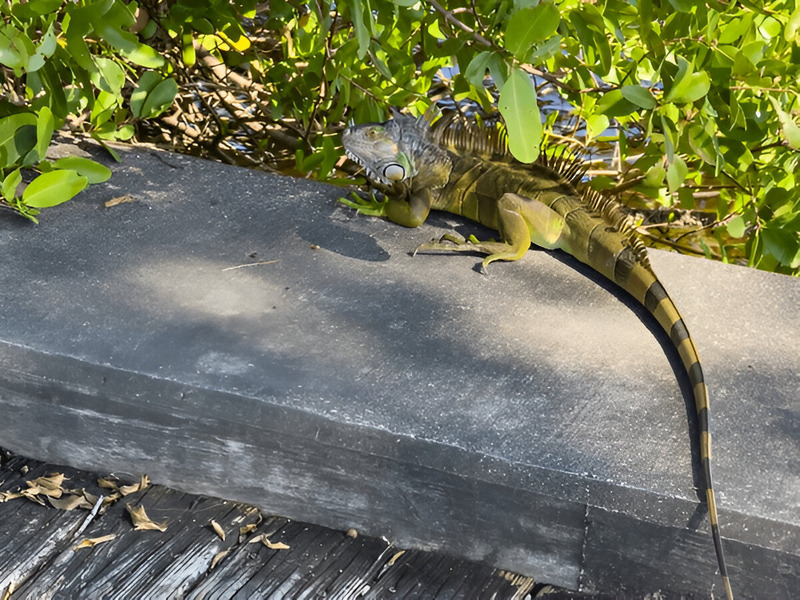
How do Iguanas communicate with each other?
Iguanas communicate primarily through visual signals and body language. They use precise physical movements, including head bobbing, push-ups, dewlap extensions, and tail flicking, to express intentions and emotional states.
Dominant or aggressive iguanas perform distinctive head bobs, while courtship and territorial claims involve bright dewlap displays. Agitated iguanas signal with quick tail flicks, and submissive individuals may perform specific push-up patterns. These non-verbal cues create a sophisticated communication system within iguana social hierarchies.
Being non-vocal reptiles, iguanas have evolved their visual communication system to efficiency. Herpetologists can interpret these signals to understand iguana social dynamics without verbal exchanges.
This species-specific signaling proves essential for territorial management, mating rituals, and conflict resolution among iguanas. Their communication exemplifies advanced behavioral adaptation within reptilian social structures, demonstrating evolutionary refinement in their signaling mechanisms.
How do Iguanas reproduce?
Iguanas reproduce by laying eggs, a method of oviparous reproduction. The breeding season begins during the dry months of January through March. Males display vibrant coloration and perform head-bobbing displays to attract females, who signal receptiveness through subtle nodding movements. Mating occurs briefly in sheltered locations like trees or burrows.
Female iguanas excavate nests in sandy soil, digging chambers 30-60 cm deep to deposit 20-70 eggs. Each egg weighs approximately 35-40 grams. Unlike some reptiles, iguanas provide no parental care; the eggs rely solely on soil protection. After mating, males and females separate. Habitat destruction can significantly disrupt laying patterns, as documented in 2018 Caribbean research during hurricane seasons.
Incubation lasts 10-12 weeks according to Breuil et al. (2019). Hatchlings emerge measuring 20-25 cm in length. These juveniles consume tender vegetation and grow rapidly, using tree-climbing abilities to escape predators. Sexual maturity occurs after 3-4 years of development.
The typical life span for iguanas ranges from 10 to 15 years in their natural habitat. The Green iguana (Iguana iguana) typically survives longer than the Lesser Antillean iguana (Iguana delicatissima) due to its adaptation to more diverse ecological niches.
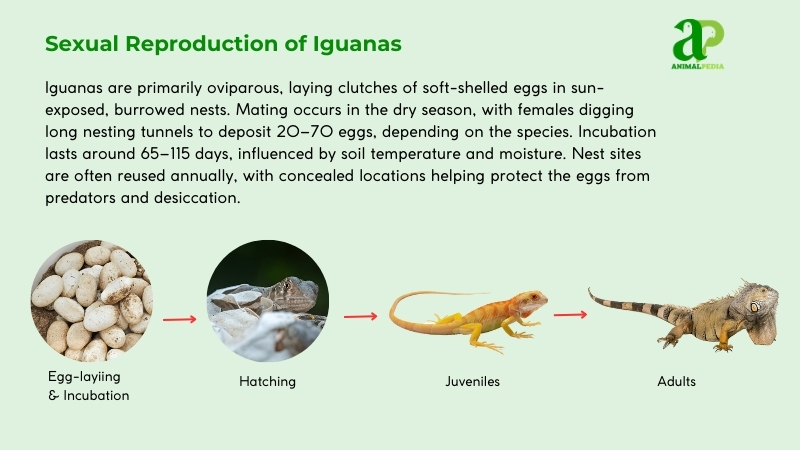
How long do Iguanas live?
Iguanas live 10-15 years in the wild. Their life cycle flows from hatchling to sexually mature adult in 3-4 years, shaped by tropical environments and plant-based diets.
Green iguanas (Iguana iguana) typically outlive their relatives, the lesser Antillean iguanas (Iguana delicatissima). This longevity difference stems from the green iguana’s wider habitat range and greater adaptability to changing conditions.
Across iguana species, the average lifespan reaches about 12 years. Research by Krysko and colleagues (2016) found no major longevity differences between males and females in natural settings.
In captivity, these reptiles often enjoy extended lives. Without predators, food shortages, or harsh weather, well-cared-for iguanas can survive up to 20 years in domestic environments.
What are the threats or predators that Iguanas face today?
Iguanas face four major threats today: habitat destruction, invasive predators, climate change, and the exotic pet trade. These dangers have a severe impact on iguana populations across tropical ecosystems.
- Habitat loss devastates iguana communities as deforestation eliminates 40% of their natural ranges, critically reducing food sources and breeding territories. Developmental encroachment fragments habitats, isolating populations.
- Invasive species pose lethal challenges. Feral dogs and introduced mammals destroy nests and consume eggs, cutting hatchling survival rates by 30%. Native predators, including raptors (hawks, owls), large snakes, and wild cats, naturally regulate iguana populations.
- Climate shifts threaten iguana survival by altering the availability of their food. Rising temperatures reduce fruit yields by 20%, directly impacting reproduction rates and population sustainability. Temperature changes also affect sex determination in developing eggs.
- The commercial trade depletes wild iguana stocks, with approximately 15% of green iguana populations (Iguana iguana) affected by collection for pets.
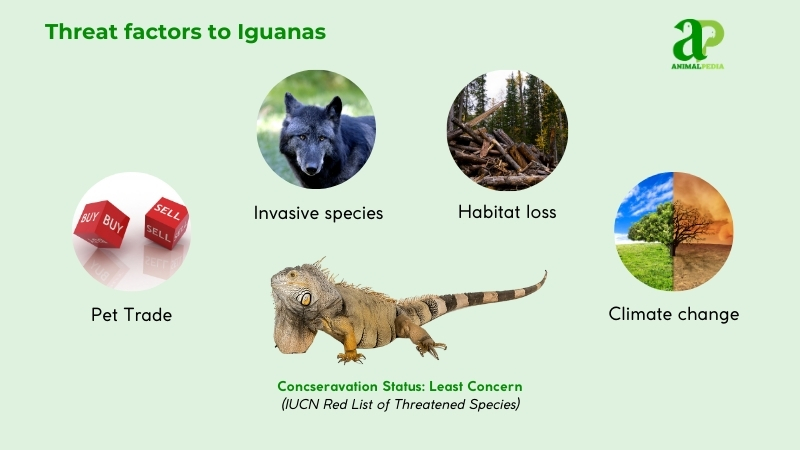
Research by Breuil et al. (2019) documents that Lesser Antillean iguanas (Iguana delicatissima) have lost half their habitat to human development since 2000, pushing this species toward extinction.
Are Iguanas endangered?
The conservation status of iguanas varies by species. The IUCN lists certain iguana taxa as “Endangered” due to severe habitat destruction and genetic hybridization. The common Green Iguana (Iguana iguana) maintains a “Least Concern” classification, with robust populations throughout its range.
Population assessments reveal fewer than 13,000 iguanas across Dominica and Martinique islands (Breuil et al., 2019). Meanwhile, Green iguana numbers reach into the millions, with stable communities throughout Central America. Critically threatened species include the Fiji Banded Iguana (Brachylophus fasciatus) and the Anegada Rock Iguana (Cyclura pinguis), both facing extinction pressures from non-native predators and ecosystem degradation.
The primary threats driving population decline in the endangered iguana species include deforestation, illegal wildlife trade, urban development, and damaging introduced species such as feral cats and dogs. These reptiles face a complex web of anthropogenic pressures across their natural territories.
What conservation efforts are underway?
The conservation status of iguanas varies by species. The IUCN lists certain iguana taxa as “Endangered” due to severe habitat destruction and genetic hybridization. The common Green Iguana (Iguana iguana) maintains a “Least Concern” classification, with robust populations throughout its range.
Population assessments reveal fewer than 13,000 iguanas across Dominica and Martinique islands (Breuil et al., 2019). Meanwhile, Green iguana numbers reach into the millions, with stable communities throughout Central America. Critically threatened species include the Fiji Banded Iguana (Brachylophus fasciatus) and the Anegada Rock Iguana (Cyclura pinguis), both facing extinction pressures from non-native predators and ecosystem degradation.
The primary threats driving population decline in endangered iguana species include deforestation, illegal wildlife trade, urban development, and damaging introduced species such as feral cats and dogs. These reptiles face a complex web of anthropogenic pressures across their natural territories.
Frequently Asked Questions
Do Iguanas Make Good Pets?
Iguanas can make good pets if you’re ready to commit. They need a spacious enclosure, a specific diet, and regular care. Consider their long lifespan and special requirements before deciding to bring one home. Plus, they are non-venomous in case you are wondering, “Are Iguanas poisonous?”.
Are Iguanas an Endangered Species?
Yes, some species like the Grand Cayman blue iguana are critically endangered due to habitat loss and poaching. Conservation efforts are essential for their survival.
What Is the Average Lifespan of Iguanas?
Iguanas’ life expectancy is approximately 15 to 20 years in the wild, but they can live up to 25 years in captivity with proper care, diet, and environment.
Can Iguanas Swim in Water?
Yes, iguanas can swim in water. They are excellent swimmers and can move swiftly through rivers and lakes. Their long tails serve as a rudder to steer while swimming, enabling them to navigate the water with ease.
Do Iguanas Interact Well With Other Animals?
Yes, iguanas can interact well with other animals. They may enjoy companionship with certain pets. However, introducing them properly and monitoring interactions is crucial for everyone’s safety and well-being.
Conclusion
Iguanas stand as reptiles in the animal kingdom. Their striking appearance—with vibrant scales and impressive crests—combines with their adaptability across diverse environments from tropical forests to coastal regions.
Their behavioral patterns, including social hierarchies and territorial displays, reveal complex survival strategies honed through evolution. The physiological adaptations these lizards possess—efficient salt glands, powerful tails, and specialized claws—demonstrate nature’s ingenious solutions to environmental challenges.
Green iguanas and their relatives represent evolutionary success stories spanning millions of years. Their continued presence in ecosystems underscores their resilience despite increasing habitat fragmentation and human encroachment. As keystone species in many environments, they contribute to ecological balance through seed dispersal and vegetation management.
The more we understand these fascinating reptiles, the better we appreciate nature’s intricate design. Their survival techniques aren’t just interesting—they’re evolutionary masterpieces worth protecting for future generations.





